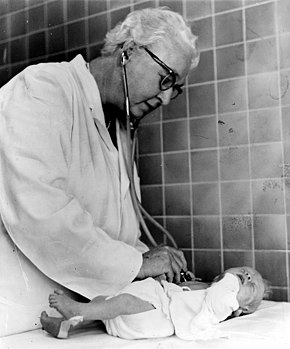| Apgar score | |
|---|---|
 Virginia Apgar, creator of the Apgar score |
The Apgar score is a quick way for health professionals to evaluate the health of all newborns at 1 and 5 minutes after birth and in response to resuscitation.[1] It was originally developed in 1952 by an anesthesiologist at Columbia University, Virginia Apgar, to address the need for a standardized way to evaluate infants shortly after birth.[2]
Today, the categories developed by Apgar used to assess the health of a newborn remain largely the same as in 1952, though the way they are implemented and used has evolved over the years.[3] The score is determined through the evaluation of the newborn in five criteria: activity (tone), pulse, grimace, appearance, and respiration. For each criterion, newborns can receive a score from 0 to 2.[1][3][4] The list of criteria is a backronym of Apgar's surname.
- ^ a b "The Apgar Score". www.acog.org. Retrieved 2021-09-10.
- ^ Calmes, Selma H. (May 2015). "Dr. Virginia Apgar and the Apgar Score: How the Apgar Score Came to Be". Anesthesia & Analgesia. 120 (5): 1060–1064. doi:10.1213/ANE.0000000000000659. ISSN 0003-2999. PMID 25899273. S2CID 41296774.
- ^ a b Simon, Leslie V.; Hashmi, Muhammad F.; Bragg, Bradley N. (2021), "APGAR Score", StatPearls, Treasure Island, Florida: StatPearls Publishing, PMID 29262097, retrieved 2021-09-10
- ^ Cite error: The named reference
:0was invoked but never defined (see the help page).